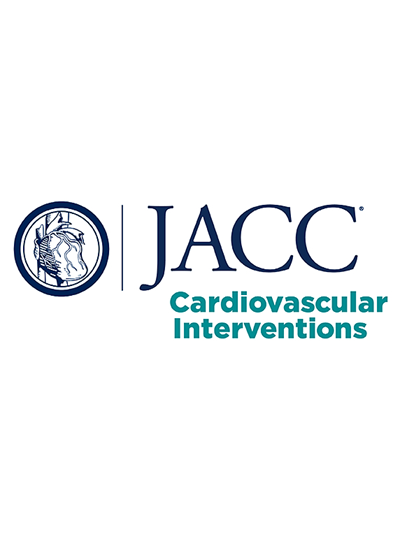心房间隔缺损封堵器 ASSURED 试验中枢组/持续通路组的长期结果。
IF 11.7
1区 医学
Q1 CARDIAC & CARDIOVASCULAR SYSTEMS
引用次数: 0
摘要
背景:GORE CARDIOFORM ASD Occluder(GCA,W. L. Gore & Associates)于2019年获批用于房间隔缺损(ASD)闭合:本研究旨在报告 ASSURED(经导管封堵房间隔缺损的安全性和有效性研究)试验的关键组和持续进入组的综合结果,直至 36 个月:这项前瞻性、多中心、单臂试验评估了使用 GCA 封闭 ASD 的程序和临床结果。主要终点是设备植入后 6 个月的闭合成功率和综合临床成功率(设备的部署/保留、安全性和闭合)。在 6 个月和 36 个月时对技术和手术成功率、安全性、临床显著新心律失常(CSNA)次要终点以及线框断裂(WFF,透视)进行评估:在 569 名尝试进行二次 ASD 闭合的患者(中位年龄 10.4 岁,中位体重 35.0 千克)中,有 526 人技术成功。ASD的平均止血直径为17.6 ± 5.3 mm。所有 478 名接受 6 个月影像学检查的患者都获得了闭合成功。6个月和36个月的综合临床成功率分别为87.6%(468/534)和84.0%(351/418)。8.1%(43/548)的患者发生了技术故障,3.9%(21/534)的患者发生了 30 天的设备或手术相关严重不良事件,2.8%(15/534)的患者发生了 6 个月的设备事件。30 天时,569 位患者中有 21 位(3.7%)出现 CSNA。6个月时,436名患者中有138名(31.7%)发生了WFF,36个月时,185名患者中有105名(56.8%)发生了WFF(无后遗症):结论:在这项大型先天性 ASD 装置试验中,GCA 取得了可接受的结果。WFFs 虽然常见,但并未导致任何临床后遗症。其独特的功能、尺寸范围和安全性扩大了后天性 ASD 闭合的选择范围。(经导管闭合峡部ASD的安全性和有效性研究 [ASSURED];NCT02985684)。本文章由计算机程序翻译,如有差异,请以英文原文为准。
Long-Term Results of the Atrial Septal Defect Occluder ASSURED Trial for Combined Pivotal/Continued Access Cohorts
Background
The GORE CARDIOFORM ASD Occluder (GCA, W. L. Gore & Associates) was approved in 2019 for ostium secundum atrial septal defect (ASD) closure.
Objectives
This study sought to report the combined pivotal and continued access cohorts of the ASSURED (Safety and Efficacy Study of Transcatheter Closure of Ostium Secundum ASDs) trial results through 36 months.
Methods
This prospective, multicenter, single-arm trial evaluated procedural and clinical outcomes of ASD closure with the GCA. The primary endpoints were 6-month closure success following device implantation and composite clinical success (deployment/retention of device, safety, and closure). Technical and procedure success, safety, clinically significant new arrhythmia (CSNA) secondary endpoints, and wire frame fracture (WFF, with fluoroscopy) at 6 and 36 months were evaluated.
Results
Of 569 patients (median age of 10.4 years and median weight of 35.0 kg) who underwent attempted secundum ASD closure, 526 were technical successes. The mean stop-flow ASD diameter was 17.6 ± 5.3 mm. All 478 patients with 6-month imaging achieved closure success. Composite clinical success at 6 and 36 months was achieved in 87.6% (468/534) and 84.0% (351/418) of patients, respectively. Technical failure occurred in 8.1% (43/548), 30-day device- or procedure-related serious adverse event in 3.9% (21/534), and 6-month device events in 2.8% (15/534) of patients. At 30 days, 21 of 569 patients (3.7%) had CSNA. At 6 months, 138 of 436 (31.7%) patients had WFFs and 105 of 185 (56.8%) at 36 months (without sequelae).
Conclusions
In this large congenital ASD device trial, the GCA had acceptable results. WFFs, although common, did not result in any clinical sequelae. The unique features, size range, and safety profile expand the options for secundum ASD closure. (Safety and Efficacy Study of Transcatheter Closure of Ostium Secundum ASDs [ASSURED]; NCT02985684)
求助全文
通过发布文献求助,成功后即可免费获取论文全文。
去求助
来源期刊

JACC. Cardiovascular interventions
CARDIAC & CARDIOVASCULAR SYSTEMS-
CiteScore
11.60
自引率
8.80%
发文量
756
审稿时长
4-8 weeks
期刊介绍:
JACC: Cardiovascular Interventions is a specialist journal launched by the Journal of the American College of Cardiology (JACC). It covers the entire field of interventional cardiovascular medicine, including cardiac, peripheral, and cerebrovascular interventions. The journal publishes studies that will impact the practice of interventional cardiovascular medicine, including clinical trials, experimental studies, and in-depth discussions by respected experts. To enhance visual understanding, the journal is published both in print and electronically, utilizing the latest technologies.
 求助内容:
求助内容: 应助结果提醒方式:
应助结果提醒方式:


